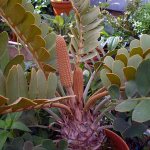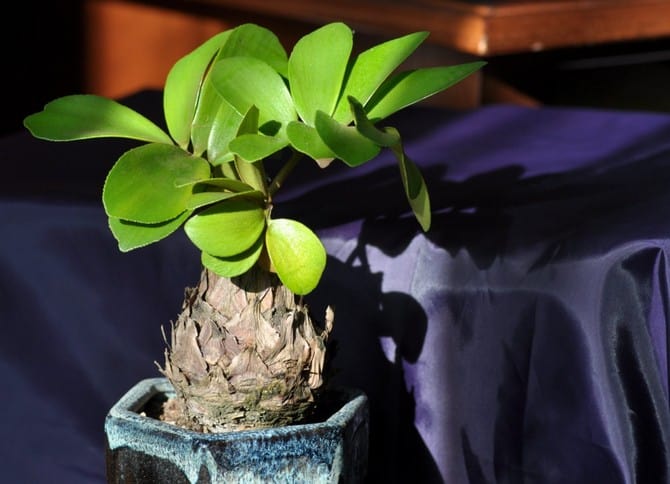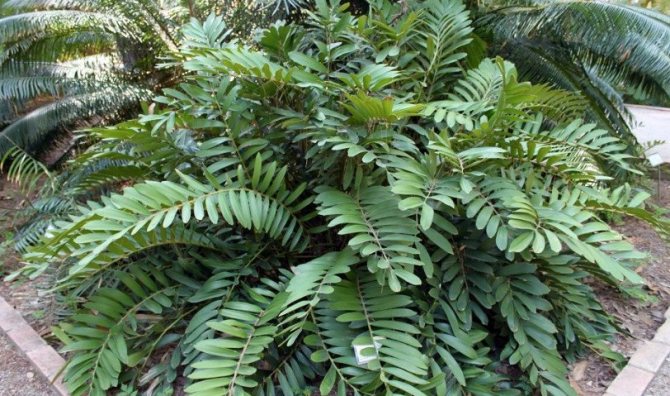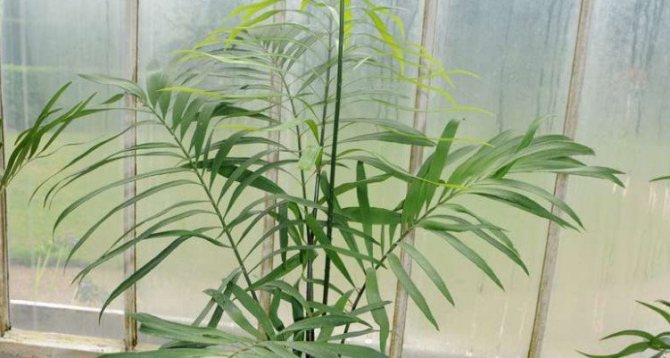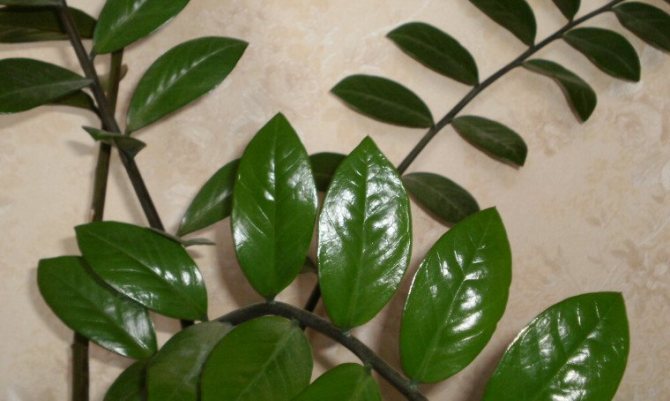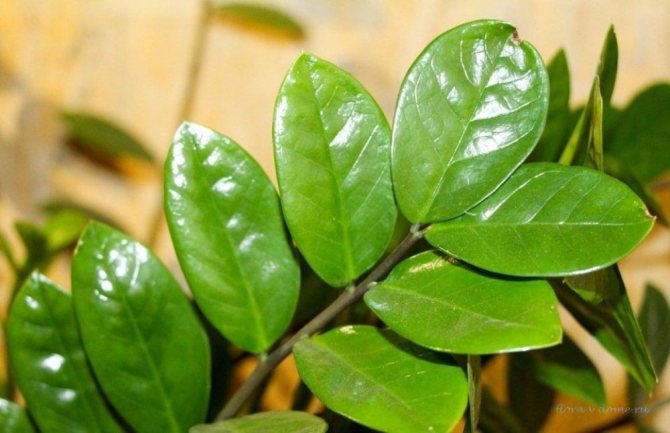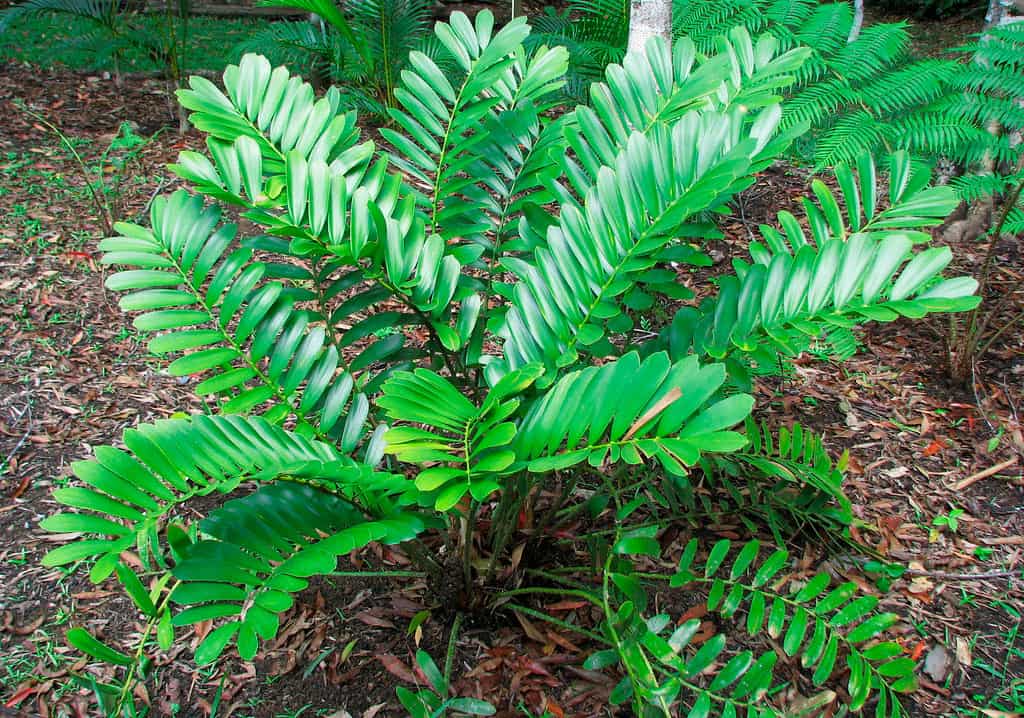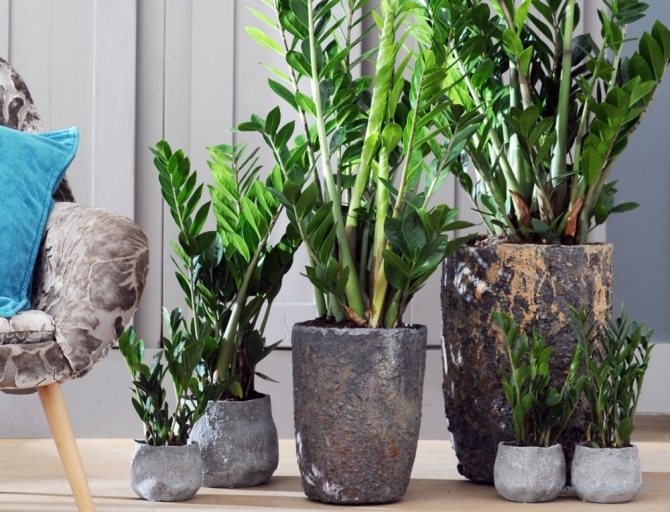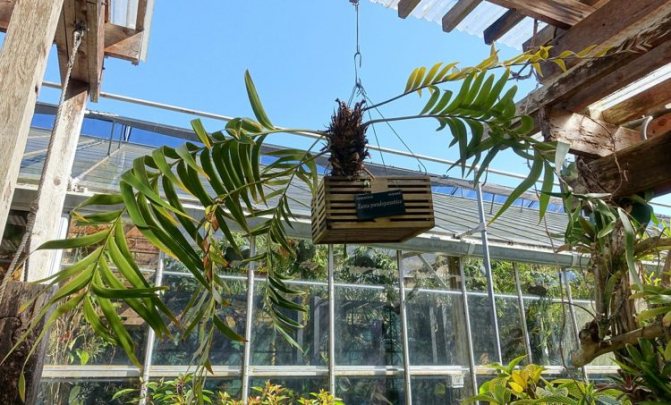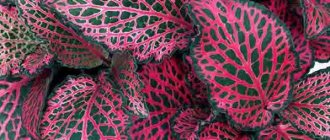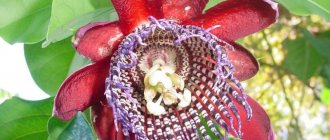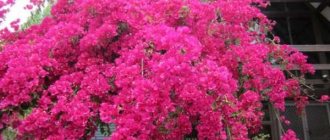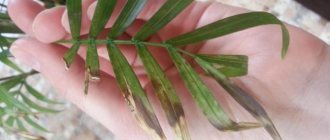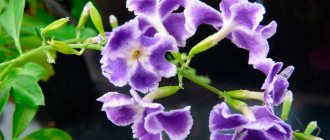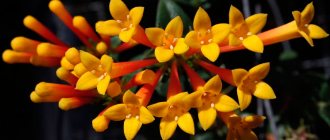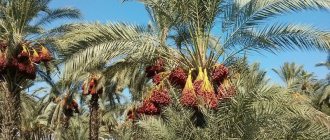Zamia (Zamia) is a typical representative of the genus Cicadovs (Sagovnikovs) from the Zamiev family, which unite a group of some of the oldest plants on the planet - "living fossils" that have survived on earth since the time of the dinosaurs.
Most species are native to the warm, humid undergrowth of the rainforests of the Americas. Some of them adapt well to the subtropical climate and are used in landscaping the garden.
However, as a houseplant, of particular interest for flower growers is powdered zamia (Zamia furfuraceа), which is not difficult to care for at home.
Characteristics and varieties of plants
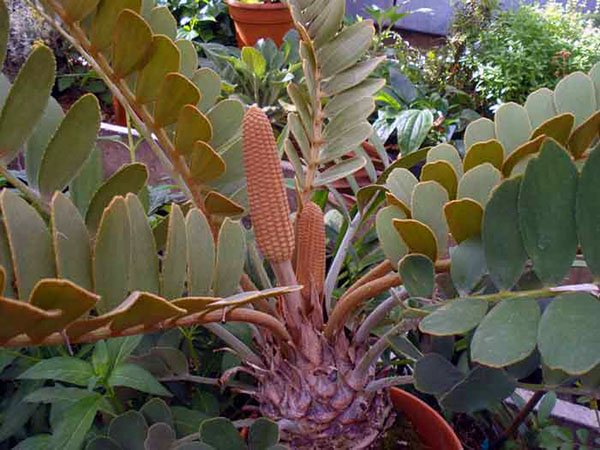
The varieties of this plant differ from each other in appearance. However, they all have a short barrel-shaped stem, from which long feathery leaves of various shapes grow. This is a dioecious flower, there are male and female specimens. In pots, representatives of zamia grow slowly:
- Zamia pseudoparasitic is a large tree that naturally grows up to 3 m in height. Leaves reach 2 m, they have elongated leaves up to 30-40 cm each.


- Powdered zamia got its name because of the unusual color of the leaves. They are oblong and have light scales on their surface. The trunk is almost completely hidden under the ground, it can only be seen in adult flowers.
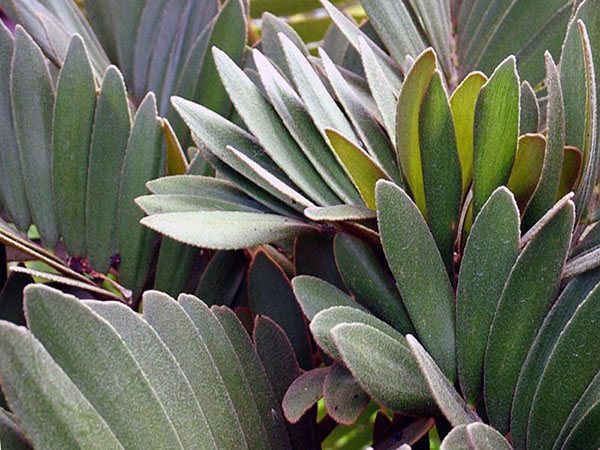

- Broad-leaved zamia is a short plant with an underground or aboveground trunk. The leaves are large, rounded leaves.
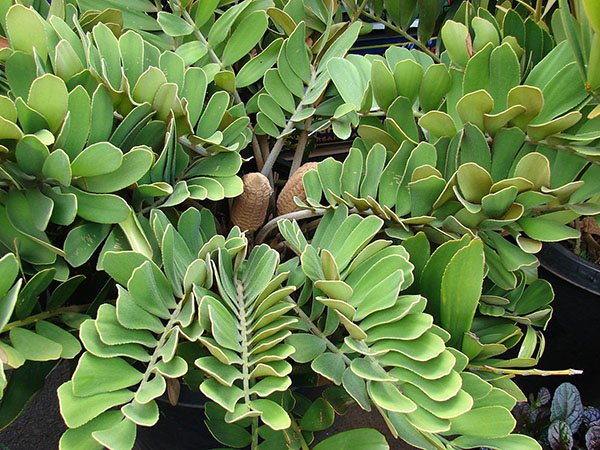

- Dwarf zamia is a variety that is perfect for growing at home. The trunk is underground, reaching 25 cm in length in adult plants. The leaves are collected in a rosette, they can grow up to 50 cm.
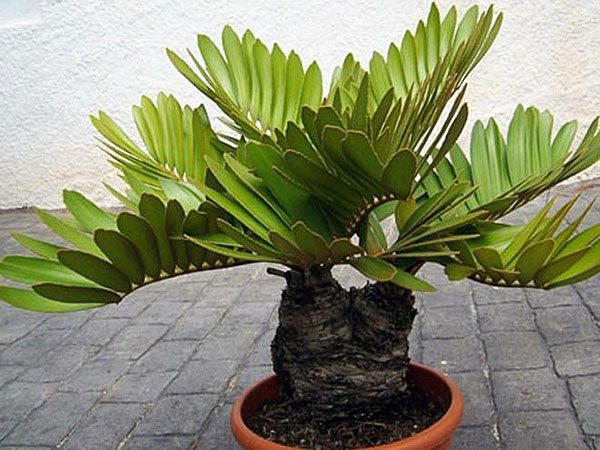

All varieties of this plant are poisonous to humans and animals. In cats and dogs, they cause allergic reactions and dermatitis.
Reproduction methods
At home, zamia is propagated by seeds or cuttings. Seed planting material cannot be obtained on your own, so you need to purchase it in a store. Landing technology:
- Fill a container with a volume of up to 300 ml with a nutrient substrate, disinfect the seeds and soil with a 1% solution of potassium permanganate.
- Embed the seeds in the soil half the length, leaving some on the surface of the substrate. Cover the container with foil or glass, put in a warm and well-lit place.
- Seedlings appear in 14-16 days, during this time it is necessary to regularly ventilate, moisten the soil by spraying as needed.
The covering material is removed when the first shoots appear. After the formation of 2 leaves, zamia can be transplanted to a permanent place.
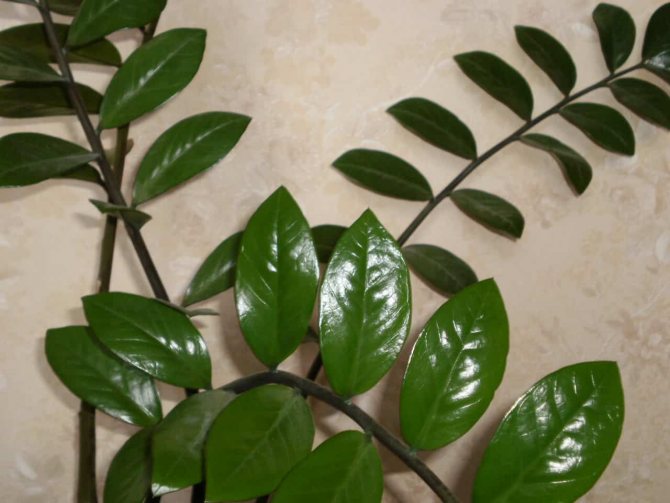

Cuttings
Planting material can only be taken from an adult plant from 2-3 years old. The optimum length of the cuttings is 10 cm. For this, a shoot with several leaves is carefully cut off, then placed in water with a solution of a growth stimulant. Rooting takes place within 2 weeks, after which the daughter plant is ready to be transplanted to a permanent place.
With this method of reproduction, development slows down significantly during the first year, so there is no need to worry if the zamia grows very slowly.
Home care rules
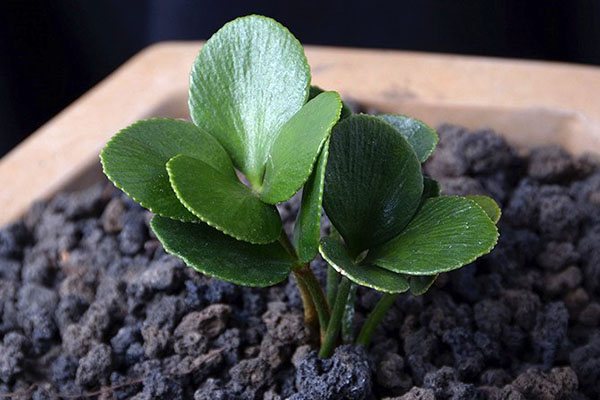

A suitable species should be chosen not only by the photo of zamia flowers, but also by their conditions of detention. They can be grown in pots at home, but it is important to create comfortable conditions for them that are as close to natural as possible. At home, the flower will not multiply, since the only way to propagate it is with the help of seeds.
Temperature and illumination
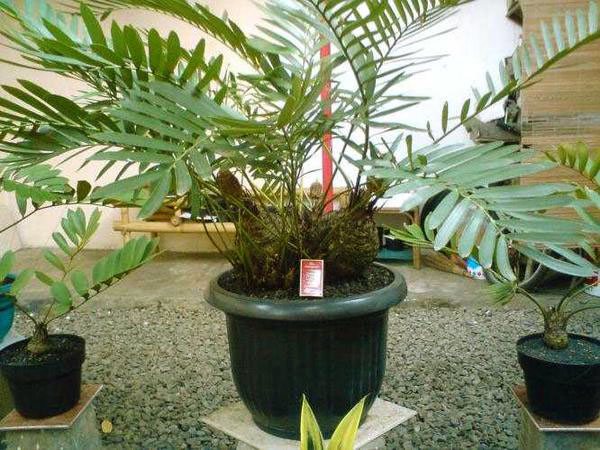

Zamia is used to growing up in well-lit areas, so she needs to organize such conditions at home. Place the pots on windowsills on the sunny side. However, on very hot days, it is better to rearrange the plant in the shade. The leaves of this flower grow in the form of a rosette, so it is important to turn the pot in different directions towards the sun. So they will be the same size and color.
All varieties of zamia are heat-loving plants. The most comfortable temperature for them is 25-28 degrees, and in winter it should not drop below 15 ᴼС. The room must be ventilated, but the container with the flower should not stand in a draft. From time to time, the leaves can be wiped off dust with a sponge.
Excessive sun exposure can cause leaf burns if the plant is not gradually prepared for these conditions.
Requirements for soil and watering
Caring for a houseplant with a zamia is not difficult. It grows well on all types of soil; a regular store substrate is suitable for planting it at home. You can also prepare it yourself from the following components:
- clay as a base - 4 parts;
- peat - 2 parts;
- humus - 2 parts;
- sand - 1 part.
In the summer, the flower needs to be watered constantly, preventing the topsoil from drying out. The water should be at room temperature or slightly warmer, but not hot. In autumn, watering is gradually reduced, and in winter it is enough to water the flower once every 3-4 weeks. It is also necessary to monitor the condition of the plant. If its leaves begin to turn yellow and fall off, it means that there is not enough moisture.
Care
Zamia is a slow-growing plant, so even with proper care, there is no need to be afraid that the flower practically does not grow.
At home, flowers are almost never formed, their development can only be achieved when growing a crop in a greenhouse. Zamia is considered one of the most unpretentious domestic palms, rarely gets sick and becomes infected with pests.
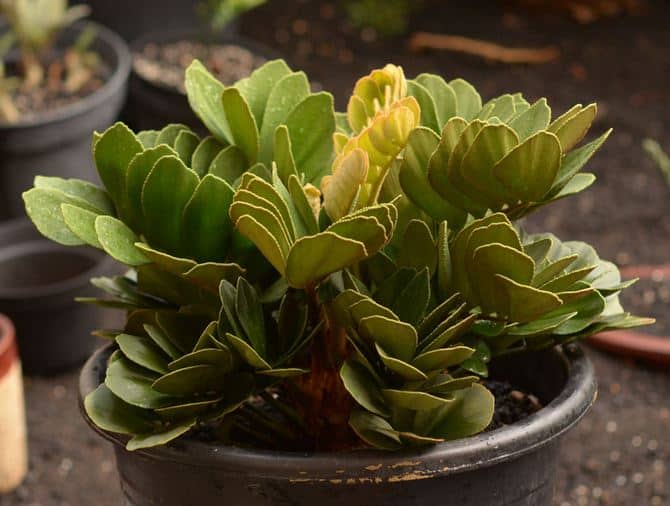

Watering
During the growing season in spring and summer, abundant watering is required. It is recommended to water the plant 1-2 times a week, but before the procedure, the condition of the soil should be assessed.
It should be a little dry, overflow should not be allowed, which leads to rotting of the roots and stem. In autumn and winter, the plant is watered with a frequency of up to 1 time in 10 days.
Water for irrigation should be used only settled, thawed or rainwater. It must be warmed up to ambient temperature. In winter, when the indoor air is particularly dry due to battery operation, the leaves can be additionally wiped or sprayed.
Top dressing
Fertilizers are applied only in the spring-autumn period after the plant comes out of hibernation. As a top dressing, it is recommended to use a complex liquid composition for ornamental plants, which contains all the necessary minerals. Fertilizers are applied once every 10-12 days by the root method, avoiding contact with the leaves.
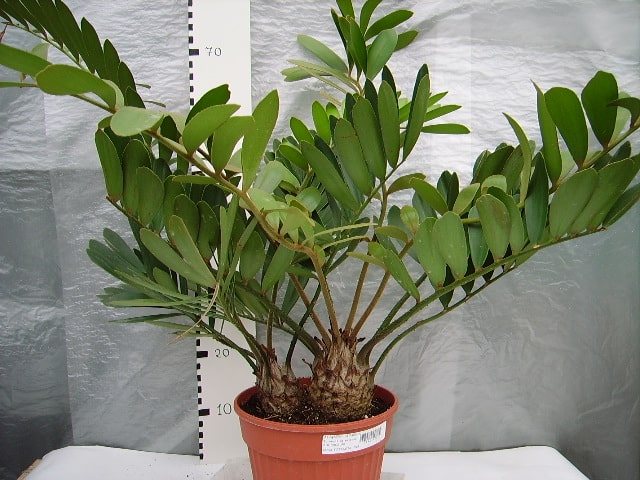

Transfer
Zamia grows slowly, so a planned transplant is required only once every 3-4 years. The procedure is carried out in the spring, when the growing season of the plant has begun. Transplant algorithm:
- Prepare a container, lay drainage on the bottom and fill it with soil by a third of the volume.
- Carefully remove the seal from the pot, clean the trunk and roots from soil residues. Spray with growth stimulant.
- Deepen the plant in a new pot so that up to 2/3 of the trunk length remains on the surface. Top up the container with soil and water.
After transplantation, place the zamie in a comfortable place, avoid any exposure for 10 days while adaptation takes place. The first top dressing is recommended to be applied no earlier than 14 days from the moment of transplantation.
Diseases and pests
With proper care, the flower grows healthy. For prevention, it does not need to be processed with anything. If the plant does not feel comfortable enough, this can be understood by the following symptoms:
- with too much watering in combination with nitrogen fertilizers, the root may begin to rot;
- in conditions of too wet soil, when the air temperature drops, the flower may die;
- sunburns look like leaf pigmentation disorders;
- parasites (spider mites, aphids and scale insects) can also appear, feed on the juices of the flower and can lead to its death.
It is not difficult to grow a zamia at home and take care of it, it is enough to keep it warm and water it regularly. It grows slowly, so an adult plant is transplanted no more than once every 5 years. However, pet owners are not advised to have this flower as it is poisonous. The poison is found in leaves and stems and can be poisoned by cats. It causes a general allergic reaction that is manifested by skin rashes, irritation, itching and hair loss.
Such an evergreen not very large plant like Zamia is directly related to the Zamiaceae family. It has a massive barrel-shaped trunk and spectacular feathery foliage. This plant comes from tropical as well as subtropical regions of America.
If we translate the name of this flower from Latin, it will turn out - loss, loss. Zamia was the name given to empty cones of conifers. And in this plant, the reproductive organs (strobila) are very similar to coniferous cones.
This not very tall evergreen has a smooth, low stem, which is often underground, elongated, tuberous. Leathery, glossy, feathery leaves are oval-shaped. Their edges are serrated or solid, at the base divided into a pair of lobes (narrow and wide). Often, parallel veins are clearly visible on the foliage, available from below, which are initially painted in a pale green color, and then turn olive. Sometimes there are some thorns on a smooth handle.
This plant is dioecious. An adult plant that has reached mature age has female leaves on which megastrobilae are located, consisting of corymbose sporophylls with a whorled arrangement, and on their lower side of the scutellum there are 2 hanging ovules. Microstrobilis are located on the leaves of the male type. This slow-growing plant blooms very rarely at home.


Illumination
He loves bright light and can easily tolerate direct sunlight, but it should be borne in mind that in the hot summer months at noon the plant should be shaded. To form a beautiful uniform leaf rosette, the palm tree must be gradually turned in different directions to the light every few days.
Temperature regime
A very thermophilic plant, which in the warm season must be provided with a sufficiently high temperature (from 25 to 28 degrees). A cool content (14-17 degrees) in winter is recommended. The room where the zamiya is located must be systematically ventilated, but at the same time protect it from cold air currents.
Humidity
There are no special requirements for air humidity. It grows and develops almost equally well with both low and high air humidity. For hygienic purposes, regular wiping of the leaves with a damp cloth is required.
How to water
In the warm season, you need to water abundantly.However, between waterings, the top layer of the substrate must necessarily dry well. For this they use exceptionally soft and settled water. With the onset of autumn, they begin to water less, and in winter, there should be poor watering. Make sure that no liquid stagnates in the soil, but at the same time the earthy clod should not completely dry out.
Top dressing
Top dressing is carried out in the warm season 1 time in 3 or 4 weeks. For this, a complex fertilizer is used for decorative deciduous houseplants. In the cold season, they do not feed.
Earth mixture
Suitable soil should be of medium density and high in nutrients. For the preparation of earth mixture,
it is necessary to combine leaf and sod land, peat, humus and sand, taken in equal shares. You also need to add crushed granite chips.
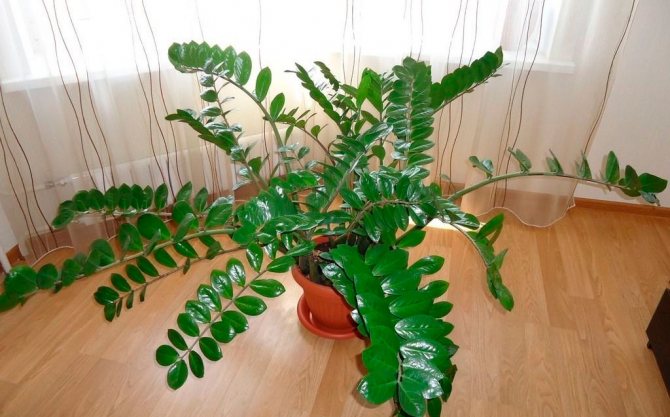

Transplant features
Since this is a slow-growing plant, it should be transplanted infrequently, as a rule, once every 3 or 4 years, and it is better to do this in the spring before the period of active growth. Don't forget good drainage.
Reproduction methods
Can be propagated by seeds or cuttings. Seeds are sown in a light soil mixture, while they should be buried by 1/2 part (of the diameter). It is necessary to cover with foil or glass and put in a warm place. The sprouts that appear dive separately into small containers.
The cuttings must first be put in water. When the roots appear, they are planted in the soil.
Pests and diseases
The scabbard can settle. If possible, pests should be removed and the leaves should be washed with soapy water. If the infection is strong, then special treatment will be required.
Water stagnation in the soil should not be allowed, as this can provoke the appearance of rot.
Possible difficulties
- The palm tree wilts and the base of the stem rots - too much watering in winter.
- Brownish, dry spots on the foliage - a lack of minerals or too little watering.
- The plant sharply dropped the foliage - it was poured with cold water or watering was too poor.
Possible problems
Diseases and pests are rare in an apartment. Among insects, scale insects are the most dangerous. When they appear, the leaves and shoots must be washed with soapy water, remove large insects with a cotton swab.
If the infection has affected most of the bush, but it is necessary to treat with a chemical insecticide (Aktara, Intavir or Iskra). The most common problems are related to improper care and conditions of detention. The main ones are:
- the appearance of dry brown spots due to a lack of minerals in the soil;
- leaf fall and reduced growth due to the use of cold water for irrigation;
- wilting of vegetative parts, the formation of soft rotting spots at the base of the stem against the background of waterlogged soil.
If you adjust the care regimen in time and maintain comfortable living conditions, the plant recovers quite quickly, development and growth resumes.
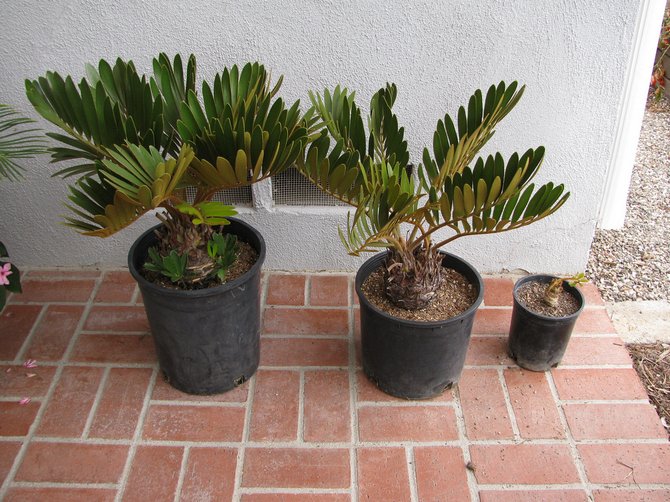

Main types
Zamia pseudoparasitica (Zamia pseudoparasitica)
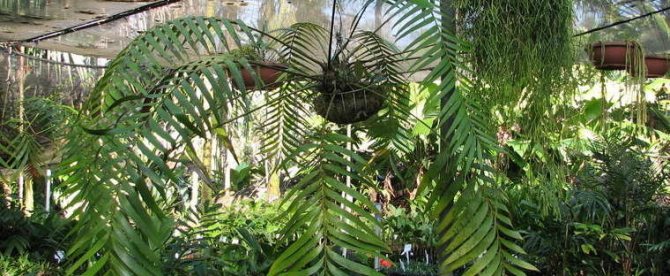

This plant is evergreen and it can reach a height of 300 centimeters. Adult zamia have foliage up to 200 centimeters long, and sparse thorns are scattered on their stalks. Linear leaves in length reach from 30 to 40 centimeters, and in width - from 2.5 to 3.5 centimeters. The toothed leaves on the lower part have pronounced longitudinal veins.
Powdered zamia (Zamia furfuracea)
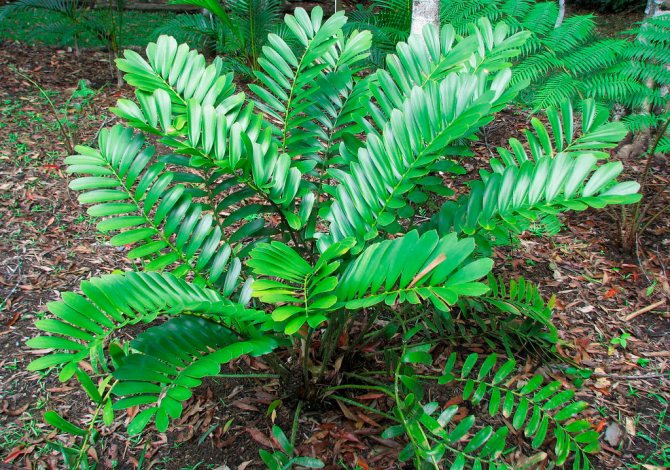

It is also an evergreen plant. Its trunk, almost completely hidden under the soil, has the shape of a turnip and on it is a bluish-gray leaf rosette, reaching from 50 to 150 centimeters in length. It happens that the trunk of an aged plant rises slightly above the surface of the soil. Leathery, dense, oblong-shaped leaves have a number of distinct, parallel veins on the seamy side.On their surface there is a dense layer consisting of light white scales, and young leaves have such a layer on 2 sides, and adults only on the seamy side.
Broad-leaved zamia (Zamia latifolia)
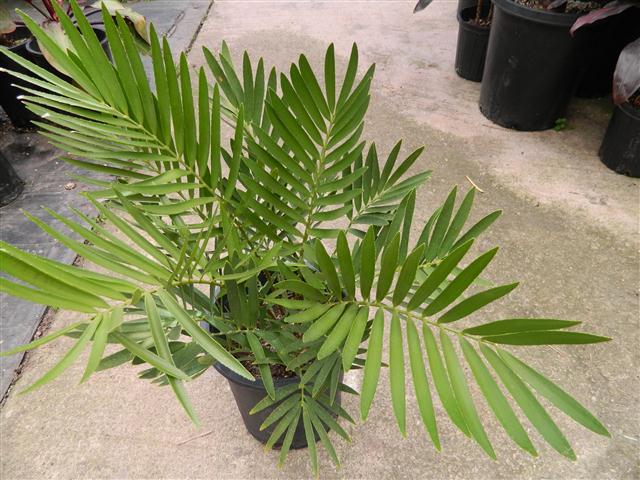

This is a low evergreen palm tree with a rather thick club-shaped trunk, which can be either completely hidden underground or rise above its surface. At its top, from 2 to 4 leaves are formed, which can be 50-100 centimeters long. The oval-oblong leaves are 5 centimeters wide and 15 to 20 centimeters long.
Dwarf zamia (Zamia pygmaea)
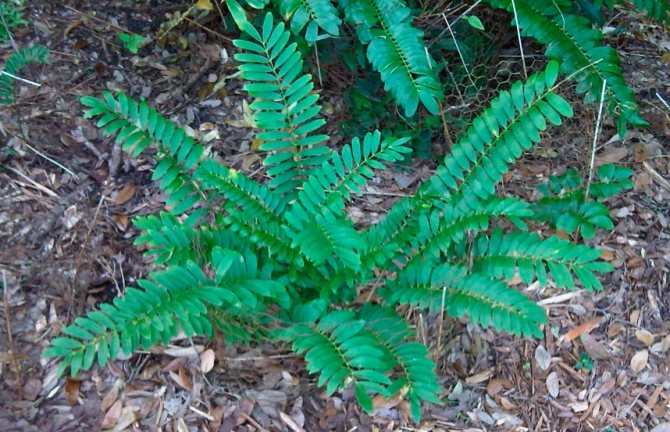

This plant is compact and evergreen, with a relatively small trunk, hidden underground, which is 25 centimeters long and 2 or 3 centimeters wide. The leaves are not very long (from 10 to 50 centimeters), with short (2 centimeters) strobili. Women's strobiles reach 5 centimeters in length. Also has tiny seeds (5 to 7 millimeters).
> Zamia - care, photos, views
Marina Chaika 08 November 2011 Category: Houseplants
Features of planting and transplanting
Zamioculcas that have not reached the age of 5 years are transplanted annually, adult plants - as needed (every 2-4 years), since they grow slowly. It is necessary that the roots completely fill the old pot. The only time suitable for transplanting is early spring, as soon as the dormant period ends.


If there is not enough space for the zamiokulkas, the plant will simply break the pot
The pot is selected not too wide, but high so that there is enough room for the roots. A ceramic container is desirable - it is heavier and more stable. There is less danger that the high zamioculcas will overturn. In terms of size, the new pot should be 3-4 cm larger in diameter. If you acquire a capacity "for growth", and so slowly growing flower will practically stop in development. Roots need time to master a new space. Only then do the leaves begin to form. Necessarily a large drainage hole and drainage, filling about a quarter of the volume of the pot.
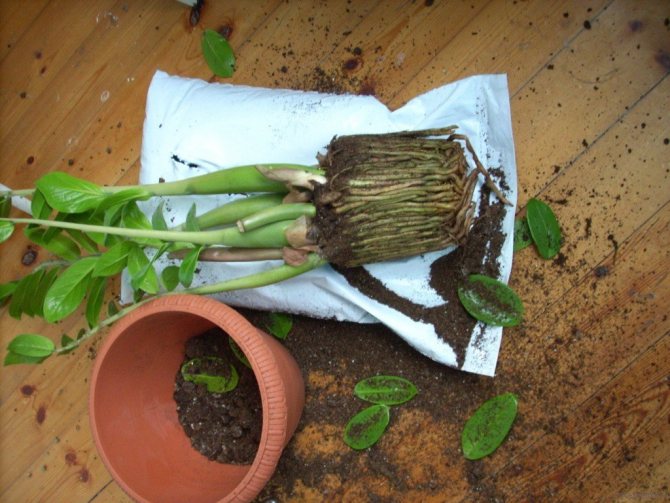

It is clearly time to transplant such a zamioculcas.
Zamioculcas prefers light, neutral soils. You can just buy a special soil for cacti and succulents in the store. But experienced flower growers prefer to prepare the substrate in person. It might look like this:
- Coarse river sand, fertile sod, leafy soil, powdered clay in a ratio of 2.5: 1: 1: 1 with the addition of sifted wood ash (a glass for every 2 liters of soil).
- Sod, leafy soil, dry peat and sand in equal proportions and a glass of crushed sphagnum moss for each liter of substrate.
- Universal soil for decorative leafy indoor plants and vermiculite (100 g per 2 l).
- Black earth, peat and sand in equal proportions.
Zamiokulkas is transplanted only by the transfer method, placing an earthen lump extracted from an old pot on a layer of moistened substrate in a new one. When adding soil, be constantly careful not to fill up the tuber. It should be located as close to the surface as possible. After transplanting, the flower is not watered for 5-7 days.
Zamiokulkas transplant - video
Home care
Lighting
Zamia needs a bright light, but despite the fact that the plant can be in direct sunlight, it is better to shade it at noon. It grows well on windows with east and west orientation, but the south side will be the best place. On the north side, zamia can grow more slowly at home. So that the plant does not get sunburn, it must be accustomed to the sun gradually. It is best to rotate a pot with a zamia plant around its axis so that the leaves in the rosette grow evenly.
Temperature
From spring to autumn, the air temperature should be between 25 and 28 ° C - the best temperature for good growth. In winter, the temperature should be twice as low - up to a maximum of 17 ° C. Stagnant air can adversely affect the development of this plant - the room needs to be ventilated.
Watering zamia
It is necessary to water the zamia after the topsoil dries up - this is in spring, summer and autumn. Since the end of autumn, watering is reduced, and in winter it is watered so as not to flood the plant, but also to prevent the earthen coma from drying out.
Spraying zamia
There is no need to spray zamia in room conditions, as well as to increase the air humidity in other ways. But it will not be superfluous to spray the zamia with settled water in summer and spring.
Top dressing zamiya
They feed home zamia in the summer and spring with complex fertilizers for indoor plants every month. In the fall, they stop feeding and begin already in the spring.
It is possible to transplant zamia, if necessary, both in spring and in summer, but it is better to do this before the plant begins to actively grow. The density of the substrate should be medium, and the substrate itself should be nutritious. The soil mixture is prepared from leaf and sod land, peat, humus and sand mixed with small pebbles. Good drainage must be at the bottom of the pot.
Zamia from seeds
For reproduction at room temperature, seeds are used, which are planted only on half of the seed in a light substrate. The seed container should be kept warm and humid. As soon as the seeds take root, you need to carefully, trying not to damage the roots, plant the seeds in individual pots.
conclusions
- Zamia is a slow-growing tropical plant that is grown as a palm tree at home.
- The plant requires moderate diffused light throughout the day, the humidity should be in the range of 60-85%.
- Flower care is reduced to regular moderate watering, top dressing in summer and spring every 10 days. The transplant is carried out every 3-4 years.
- If the rules of cultivation are not followed, growth and development slows down, signs of decay appear on the leaves and stem, and the leaves begin to fade.
Types of zamiya
Zamia pseudoparasitic / Zamia pseudoparasitica
Or Zamia roezli. It lives in forests in the tropical zones of Ecuador, Panama, Colombia and Peru, where it grows on tree trunks or in the soil. The trunk grows up to 3 m in height, and the leaves up to 2 m in length. The leaf petiole is covered with rare thorns. The leaflets are serrated along the edges, a longitudinal vein is distinguished on the underside of the leaflet. The length of the leaves is up to 40 cm, and the width is up to three and a half.
Powdered Zamia / Zamia furfuracea
This species lives in Mexico. The trunk of this species is almost completely underground - only in very old plants the trunk can peep out of the ground, but a maximum of 20 cm.The leaves are beautiful, gray-blue in color, in length from 0.5 to 1.5 m. The leaves are pinnate, oblong or ovate-oblong, there are up to 13 pairs; leathery to the touch and very dense, with prominent veins on the underside of the leaflet. Young leaves are densely covered with whitish scales on both sides of the leaf, and old ones - from the bottom.
Zamia broadleaf / Zamia latifolia
The homeland is the forests of Honduras. The plant is short, tuberous thick trunk grows up to 10 cm, but usually it is underground. Leaves from 0.5 to 1 m long grow at the top in 2-4 pieces. Leaves on a sheet from 15 to 40 pairs. The length of the leaves is 15-20 cm, and the width is up to 5 cm; shape - elongated oval.
Zamia is a plant belonging to the genus Cycadaceae of the Zamiev family. The natural habitat is the subtropics, tropics of North and South America. The plant is about 2000 years old - it grew back in the days of the dinosaurs.
The name of the plant, translated from the Latin language, means "damage", "loss". Most likely this is due to the fact that the fruits of zamia are similar in appearance to cones-pacifiers of conifers.When grown indoors, flowering is rare.
The root system of the plant is unusual, it consists of several types of roots. First, the primary root appears - it is equal to the thickness of the trunk, does not branch. Then contractile roots grow - small thin roots that allow holding the heavy trunk. Corraloids appear later - nodules that come out to the surface of the soil and serve to assimilate nitrogen from the atmosphere.
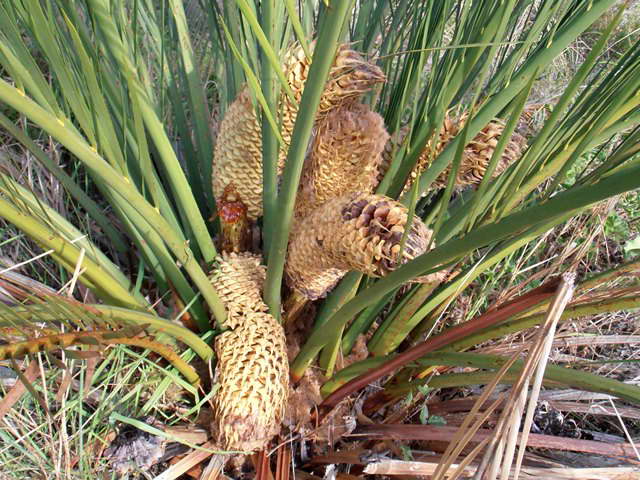

Zamia fruits photo
The evergreen zamia plant has a smooth pear-shaped trunk located under the soil, so sometimes the leaves appear to be growing directly from the soil. The crown of the trunk is crowned with a leaf rosette, consisting of wai (loose-feathery leaf plates). Each leaf is oblong, oval or pointed. Young leaves are twisted in the form of a snail. Plant height ranges from 25 cm to 2 m.
Be careful when leaving, because zamia is poisonous to humans and animals. If you do not want your pet to be accidentally hurt, it is best to refuse to have a flower.
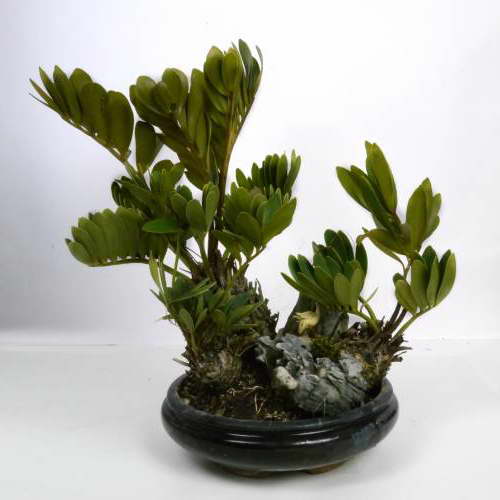

Bonsai from zamiyah photo
Lighting and location selection
Lighting must be bright, uniform (put in the middle of the window sill). Get used to direct sunlight gradually, but limit your stay under them so that burns do not appear. The ideal place is the windows of the east, west and south orientation.
Zamia loves fresh air - ventilate the room well, in the warm season, take the plant outside, but return it back at night.
Air temperature
A resident of the tropics needs a warm air temperature, without sudden changes. From spring to late autumn, maintain a temperature range of 20-25 ° C, then a decrease to 10 ° C is possible. Zamia is able to withstand a short-term temperature drop to a maximum of 0 ° C.
Watering and humidity
For watering and spraying, use soft water, it should be warm (at least room temperature, you can warm it up a little under the sun).
The air humidity must be high (at least 60%). Spray the leaves of the plant and the area around it with a fine spray daily. Wipe the leaves every 2-3 weeks with a damp sponge or soft cloth. It is good to place an aquarium next to it. Use humidifiers. Dry air will negatively affect the condition of the plant - do not place it near heating systems.
Watering is necessary in moderation. Make sure that the top layer of the soil does not dry out, but it is not worth pouring either, otherwise rot may appear. Yellowing and falling leaves indicate a lack of watering. In summer, water about 1 time a week, with the onset of cold weather - it is enough to water 1 time every 2-3 weeks.
Top dressing
During the period of active growth (spring-summer), apply complex mineral fertilizers every 20 days. No additional feeding is needed in autumn and winter.
Each leaf is difficult for the plant: they appear and grow not simultaneously, but after each other, develop slowly. Pruning is contraindicated - there is a risk of ruining the plant by cutting the leaf by 10-20 cm.
Conditions for growing at home
The flower is recommended for keeping in spacious halls, rooms, salons, study rooms, offices, shop windows or cafes.
Did you know? To the touch, the leaves of the rough (Cardboard palm) are very specific, resemble cardboard, hence the name
«
cardboard palm
»
.
Location and lighting
An ideal place in a living room for keeping a palm tree is south facing windows. Also adapts to west or east facing windows. In order to grow a beautiful plant with a uniformly developed rosette of leaves, the flower pot must be turned from time to time in different directions towards the light.
However, at the windows of the northern direction, culture may not have enough light for normal development. Zamia prefers bright light.But keep in mind that it cannot be transferred directly to the sun's rays. Accustom the flower to direct sun gradually, to avoid burns on the leaves. And on a sultry afternoon, it is better to shade the culture.


Temperature regime
In spring and summer seasons, a comfortable temperature for a plant is + 25 ... + 28 ° С, but in winter the indicator is reduced to + 14 ... + 17 ° С.
Air humidity
Zamia can withstand fairly dry indoor air. Additional measures to increase air humidity are not required. However, in the spring and summer, you can spray the plant with soft water at room temperature.
Important! Zamia does not like stagnant air, so the room must be constantly ventilated. Also, through winds should not be allowed.
Diseases, pests, other difficulties
The plant is not exposed to various diseases, but a number of mistakes in care leads to a painful condition of zamiya or even death.
- From prolonged exposure to direct sunlight, the leaves become discolored, turn yellow, and fall off.
- Waterlogging combined with an increased amount of nitrogen fertilizers leads to decay of the root system - the plant will die.
- Simultaneous waterlogging with hypothermia is detrimental to the plant.
- Do not be alarmed if the shoots are growing very slowly (literally they may not move from place for several years) - this is a normal process.
Zamia: why leaves turn yellow and what to do
The flower reacts very negatively to drafts and hypothermia, which may result in yellowing and falling leaves. Here, Epin, Zircon, Orton Rost means will help, which help the plant to cope with the stress received.
Leaves may turn yellow after transplanting when roots have been damaged. In this case, you need to water with a solution of root to accelerate root formation.
If you see the progressing process of yellowing of the leaves with their falling off, the plant becomes covered with spots - this is already an infectious, putrefactive or fungal disease. Treat the soil and flower with phytosporin, or better, transplant it into a clean pot and fresh soil, carefully examining the roots and cutting off the rotten ones. Before planting, hold the flower for half an hour in a phytosporin solution.
Yellowing of the leaves can also be a symptom of pest infestation.
Pests
Sucking pests appear on the plant: aphids, scale insects, spider mites. First, dampen a cotton ball or sponge with soapy water and wipe the pests off the leaves. Treat with insecticide, repeating the procedure after a week.
What does zamioculcas look like and where does it come from?


In nature, the leaves of zamiokulkas grow up to 1 m in length, at home the parameters are a little more modest
The genus Zamioculcas (Zamioculcas) belongs to the Aroid family (Araceae). Various sources distinguish from 1 to 4 representatives in it, but the most common opinion is that zamiifolia, aka loddigesii, is one of a kind.
The homeland of Zamiokulkas is the eastern and southeastern African mountain plateaus with a tropical climate, therefore, unlike other Aroids, it is a succulent. It is a short herb with a tuber-like rhizome, from which thick worm-like roots extend. Zamioculcas tuber is very powerful. It may even break the pot, preventing it from growing further.


In the tubers of zamiokulkas - its emergency reserve in case of a sudden drought
The petioles and the central vein (rachis) of the leaves are also juicy, dense, covered with ink-colored spots. In all its parts, the plant stores moisture and essential nutrients. Interestingly, during a severe drought, zamiokulkas can shed the leaf plate itself, thus reducing the surface from which valuable moisture evaporates, and leave the thick fleshy petiole and rachis.
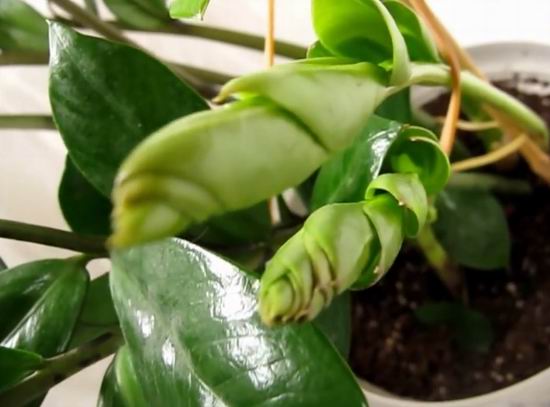

Young leaves of zamioculcas are rolled up into something resembling a tube
In addition to the official name, zamioculcas has many popular nicknames.It is known as the dollar tree, zanzibar pearl, eternal tree, aroid palm, ZZ. It is extremely popular in China and is called the "Chinese New Year plant".
The plant blooms very rarely, even in nature, only if it grows well enough and gets stronger. The inflorescence, however, is rather inconspicuous - a thick yellowish or creamy ear, enveloped in a pale green petal-bedspread. The peduncle is low, formed at the base of one of the leaves. Seeds "in captivity" are not set, even under the condition of artificial pollination. In nature, after flowering, berries ripen (each has only one seed). Experienced flower growers note that flowering often means the end of the life of a given specimen.
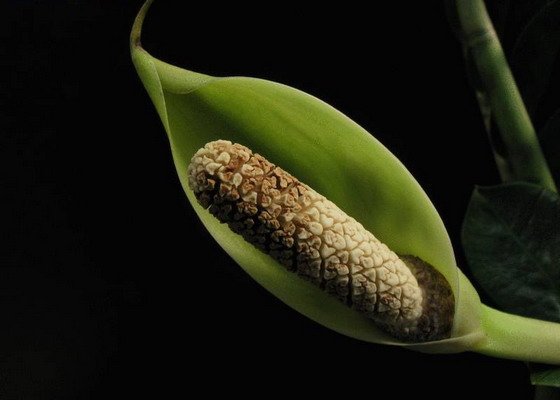

Zamiokulkas bloom is not the most attractive sight
Basically, the plant is valued for the decorative effect of the leaves. They really look very elegant - dark green, leathery, shiny, large (in nature - about a meter, at home - half as much), regular shape. In addition, which is practically not found in the Aroids, the leaf blade is not continuous, it is dissected into 8–12 separate "feathers". The leaves are densely arranged on a thick, short underground stem, giving the illusion of a rosette. Zamioculcas grows slowly, it sheds old leaves faster than new ones appear.
Like all Aroids, Zamioculcas is poisonous. Its leaves contain juice, which, when it gets on the skin (especially sensitive) and mucous membranes, can cause allergic reactions, serious burns, stomach and intestinal disorders. Therefore, all work with the flower should be carried out only with gloves, at the end, wash your hands thoroughly, and remove the pot where small children and pets cannot reach it.
Plant video
Signs and superstitions
Zamioculcas among indoor plants will be among the leaders in terms of the number of superstitions associated with it. But just a few decades ago, no one knew about the flower, with the exception of specialists of the corresponding profile. That all changed in the mid-90s when one of the Dutch florals marketed the plant itself and its smaller breeding hybrid. The novelty was quickly appreciated by amateur flower growers, florists, and designers, who began to widely use it for landscaping offices and industrial premises. As a result, zamiokulkas took the first place in sales.


Zamioculcas is widely used in the design of office premises, lobbies, foyers, offices
Why is it believed that zamioculcas brings good luck in matters related to finances, "attracting" the American currency to its owner? Probably, the fact is that it is very rare to find a bank office where this flower is absent. To some, its beautiful dark green shiny leaves probably resembled dollar bills. Another possible explanation is that the first copies that appeared on sale were quite expensive, so they were most often purchased for dollars. So the flower got its main unofficial name - the dollar tree, or the dollar palm tree.
And when the plant begins to ache and wither, you will undoubtedly face a personal financial crisis. Therefore, the flower needs to be treated urgently. If all the measures taken do not give a result, you need to get a new copy and put it next to the old one that has not yet died, so that the "newbie" will adopt from him the positive energy and the right attitude. The catch is that it is prohibited to acquire zamioculcas. You need to either steal it, or receive it as a gift.


To attract money to the house with the help of zamiokulkas, a whole ritual has been developed
Another unofficial name for zamiokulkas is the flower of celibacy. It is believed that a girl who wants to get married is strictly prohibited from growing this flower. He not only does not allow to establish existing relations, but also "discourages" future gentlemen from her, helping to ensure that men do not stay in the house.Perhaps such an ill fame, promising the owner of a flower for life loneliness, is associated with the external similarity of its flowers with spathiphyllum, which is stubbornly considered one of the most powerful "muzhegon". Therefore, its "mystical" properties were simply transferred to zamioculcas.
If you still really want to grow zamioculcas at home, you need to receive the plant as a gift or steal it. Courageous ladies who are not afraid of accepting, do not note any sudden interference or other negative changes in their personal lives.
Optimal conditions for growing a flower - table
| Factor | Recommendations |
| Location | Zamioculcas tolerates direct sunlight well, so the sill of a window facing south is quite suitable. But in the hottest hours in summer (11: 00-14: 00), especially when there is a lack of fresh air, the flower should be shaded. The ideal location is near a window that faces southeast or southwest. Provide good ventilation (the plant is not afraid of drafts). In summer, it is useful to take the flower out into the open air, protecting it from precipitation. |
| Lighting | Bright light for zamiokulkas is vital. It can be either direct sunlight or diffused lighting. If you have just purchased a plant or it has run out of dormancy, adapt it to new conditions gradually, over 10-14 days. |
| Temperature | The optimum temperature in the phase of active growth is 22–27 ºС. In winter, it is reduced to 15–17 ºС. The flower has a very negative attitude to sharp changes. |
| Air humidity | An insignificant factor. Zamioculcas may well exist in an apartment, where humidity rarely rises above 40-50%. But in summer, in order to increase the decorative effect and wash off the dust, the leaves can be sprayed or wiped with a damp sponge every 2-3 weeks. |
| Support presence | An adult zamioculcas reaches a height of about 1 m, so it may well fall to one side. To prevent this from happening, at the same time as the next transplant, stick a support made of wood or plastic with rings into the ground. |
Types of images with photos and names
The genus has about 58 species, consider the popular ones in ornamental cultivation.
Zamia pygmy Zamia pygmaea
Zamia pygmy Zamia pygmaea photo
The shortest species. The trunk is 25 cm high and about 3 cm wide, almost completely hidden under the soil surface. The length of the wai ranges from 5 cm to half a meter.
Zamia silicea Zamia silicea
Zamia silicea Zamia silicea photo
The stem is completely hidden, 3-5 leaves are located on the surface. Able to withstand short-term drought, feeding on substances from the nodules.
Zamia pseudoparasitic Zamia pseudoparasitica
Zamia pseudoparasitic Zamia pseudoparasitica photo
The height of the trunk reaches 3 m. The wais stretch up to 2 m and have pubescence. The leaves are pointed.
Zamia floridana Zamia floridana
Zamia Florida Zamia floridana photo
The stem is completely underground. A strobilus is formed above the soil among the leaves.
Zamia Rough or powdered Zamia furfuracea
Zamia Rough or powdered Zamia furfuracea photo
It has a trunk up to 1 m high, the vai are limited to the same length. The leaves are covered with rusty-brown hairs.
Zamioculcas plant immediately after purchase
First of all, withstand the adaptation period - this is about two to three weeks. Then you can safely get down to business - to transplant the plant, while taking into account the seasons and the age of your green pet (you should not transplant too young a plant at first).
Pot selection
It is not recommended to use ceramic pots, the plant may die in it due to lack of space. It is also worth postponing with plastic pots, because when the roots grow, it will not be so easy to transplant it without damaging it.
The container for the flower should be chosen not in height, but in width, since it will be very difficult to get a plant out of a narrow and elongated pot when it becomes necessary to transplant it.Also, a purchased temporary pot is not very suitable, ideally - it should not be too large or narrow.
Main varieties
The most popular types of room loan:
- False parasitic;
- Powdered;
- Broadleaf;
- Dwarf;
- Husky;
- Florida.
All these species are suitable for indoor cultivation, mainly differ in the shape of the leaves. In a dwarf variety, they are more rounded, and Zamia pseudoparasitica has very long, thin leaves with a pointed tip.


Florida
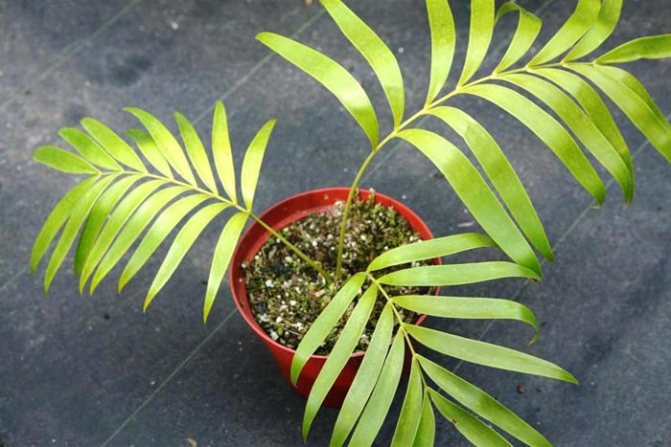

Pseudoparasitic
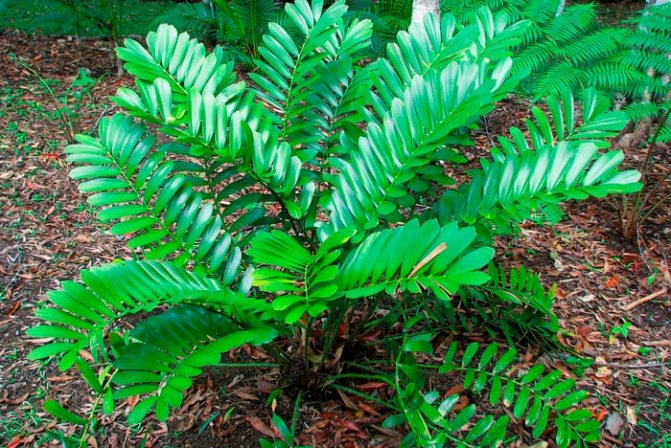

Powdered


Husky
Microclimate
The main stimulator of good growth and the absence of problems in the process of growing zamia is the indoor microclimate.
Location and lighting
Zamia is very demanding on lighting, loves bright sunlight and does not respond well to growing in full shade. The plant also tolerates direct sunlight well if it is gradually accustomed to the sun (from partial shade it is sometimes exposed to the bright sun, gradually increasing the amount of time).
Important! The plant has a tendency to uneven development of deciduous plates, due to the fact that some of them may feel a lack of sunlight, so it is recommended to unfold the pot sometimes so that all leaves are evenly illuminated.
As for the location of the zamia, it should be a southern window sill, a western or eastern one is also suitable. The location should be free of drafts.
Temperature and humidity
In the spring-summer period, the air temperature in the premise should be + 25 ... + 28 degrees, in autumn the temperature should be slightly lowered to +20, and in winter - to +18 degrees. Strong temperature fluctuations during the day and at night should not be allowed; fluctuations of only 2-3 degrees are allowed.
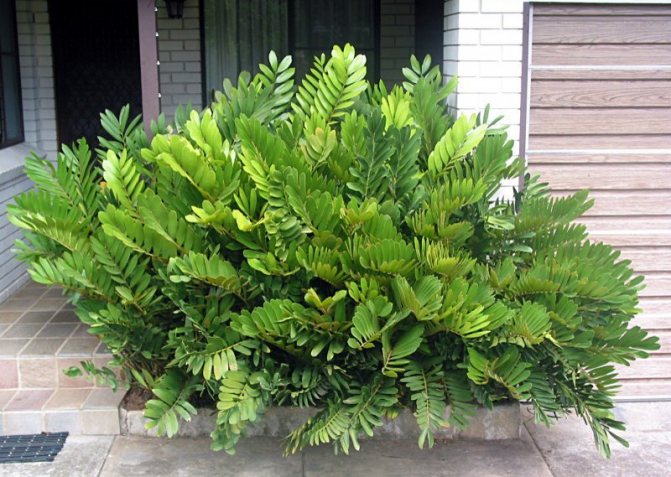

Zamia will feel bad if the air temperature in the room drops below +16 ° C, when it drops to +12 ° C - the plant develops severe stress, it starts to hurt, if the temperature is not adjusted, the zamia will die.
It is not necessary to maintain high humidity in an apartment for growing zamia, it grows well even with average humidity. In the hot summer period, the humidity can rise to 75–80%, the rest of the time - 50–60% is enough.
Where can one buy?
You can buy it at a flower shop or order online. The cost depends on the type of plant, its height and the diameter of the flowerpot, on average it is 450-2.5 thousand rubles.
What to do right after buying a flower?
Before buying a zamiya, you must carefully examine it and, if you find foreign stains, plaque, moss on the soil surface, choose another copy.
If the acquired plant has a highly developed root system, when the roots are visible above the surface of the soil, it must be transplanted into a larger container.
Reproduction of zamia
Using cuttings, a young branch should be selected and carefully separated from the mother plant. The resulting seedling must be planted in a small pot with a sand and peat mixture. Then the cutting should be covered with plastic wrap or placed under a cut plastic bottle.
Every day, a young plant must be ventilated for 15 minutes. The moisture content of the soil also needs to be carefully monitored, conducting timely watering so that the soil does not dry out. When the cutting takes root, it can be planted in a large pot, having previously created a drainage layer of large expanded clay. Young zamia is planted in a mixture suitable for her.
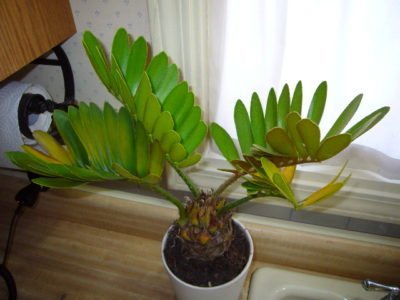

Types and varieties
In nature, you can find about 60 varieties of this flower, but not all of them withstand home growing conditions.


Types of zamia that can be found on sale in flower shops:
- Dwarf... A unique endemic species that is found exclusively in Cuba in sandy soils.The main characteristic is small size, which is an advantage when there is a shortage of space in the room. The trunk is located under the ground level, and shortened leaves up to 40 cm in size grow on the surface. The underground part of the trunk is extended by 25 cm, therefore, a deep pot is required during cultivation so that the rhizome and trunk can develop normally. Natural data make it very drought tolerant, it can grow at high temperatures in sandy conditions.
- Siliceous. At the same time, it grows only 3-5 leaves, as soon as a new one appears, one of the old dries up and is discarded. The stem develops underground and stores nutrients in itself, which becomes necessary during a period of shortage of rainfall and nutrition.
- Pseudoparasitic... Homeland - Peru, Ecuador and Panama. This variety received this name because it can successfully grow both in the ground and on the trunks of trees with thick bark, resembling parasitic plants. The squat short, thickened stem is crowned with very long leaves, each of which reaches 3 m in height, there are thorns on the petioles in some places. For indoor growing, the size is much more modest and directly depends on the volume of the pot. The pseudoparasitic form grows to its natural height in greenhouses and greenhouses, but this takes many years, since the growth rate is very slow.
- Florida... One of the deciduous species that sheds leaves when the air temperature drops below 15 ° C. It has a very long root, therefore it requires transplanting into a narrow and deep pot. In female specimens, long strobiles grow, which, under their own weight, lie on the ground. Smooth and shiny leaf plates are characteristic.
- Powdered (scaly). Lives in Mexico. It is very popular as a decorative flower in America and Asia. This type is most often presented on sale. In young specimens, the trunk is completely located inside the soil, and only over time, the upper part gradually comes out. The name is due to the fact that small white scales are visible on the young leaves above and below. On old leaves on the upper side, they disappear and remain only from the bottom. Forms 12-13 leaves, which are bent downwards, therefore, it resembles a large green ball.
- Broadleaf... Medium-sized form with foliage up to 1 m in height. The cone-shaped trunk is placed above the soil surface and gives the plant a special exotic look. At its top, 2-4 oblong leaves grow.
Often, zamia is confused with zamiokulkas, because they have similar shoots. But these are completely different plants that are not difficult to distinguish from each other. The main distinguishing feature can be considered the large rounded tubers of the zamiokulkas, from which the shoots grow. Zamiya does not have such tubers.
Lighting and a comfortable place
Cardboard palm grows well in bright, diffused light. The most suitable place for zamiya is the window sill of the western or eastern window. Shading will be required on the southern windowsill, since the plant cannot stand exposure to direct sunlight.
It should not be placed near heating appliances and in a draft, while the room where the zamia grows must be regularly ventilated. With the arrival of spring, you can take it out to the balcony or garden, after shading it.
Expert opinion
Mokhov Andrey Petrovich
Graduated from KubSAU specialty: agronomy
The zamia should be turned every 2-3 days relative to the light to ensure uniform formation of the leaf rosette. In the shade, the plant slows down or stops growth altogether.
Botanical description of the plant
The genus of these plants belongs to the Zamiev family, which settled in the tropics and subtropics of America.Depending on the type of zamia, it is characterized by the presence of a low, underground, tuberous trunk, which is covered with scars from dead leaves. There are not very many leaves on the plant, they have a loose-pinnate structure.
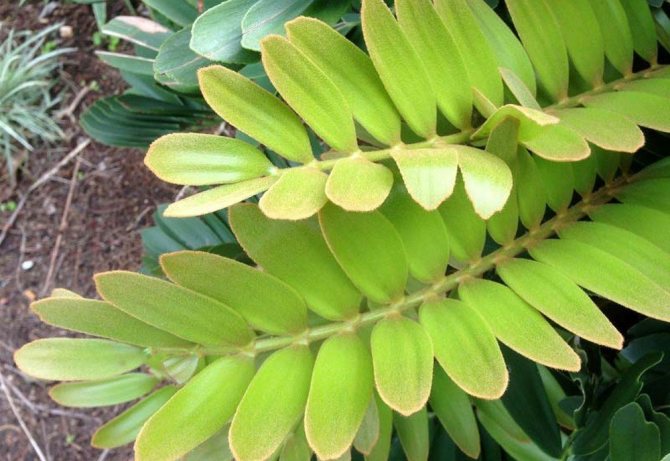

The petioles may be smooth or contain few spines. The leaves are quite dense, can be oval or lanceolate, at the base they have a wide and narrow lobe, the edge is solid or serrated. Some species have leaves with hard, dense and prominent parallel veins.
Did you know? The word "zamia" is translated from Latin as loss or damage. In ancient times, empty or damaged cones of conifers were called zamias.
At home, zamia almost never blooms. It is possible to observe flowering in the wild, although the flower in the usual representation of this word, in zamia, is very peculiar and in appearance resembles an ear of corn with unripe (empty) grains.
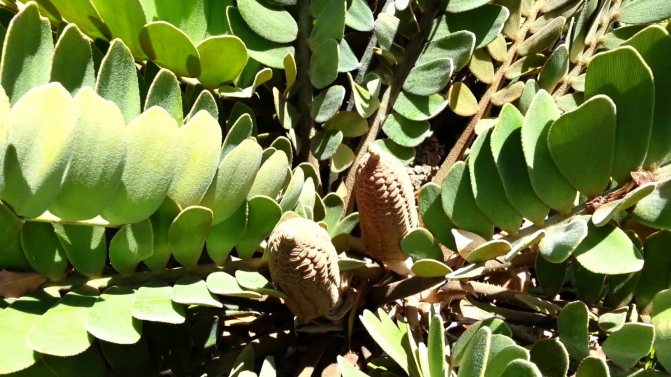

Over time, the inflorescence darkens and becomes like a bump in which seeds are formed. The flower is milky yellow, eventually turns into a fruit and acquires a brownish-gray color. Flowering falls in the middle of summer.
| Root system | Powerful, long |
| Stem | The main stem is thick and small, with a rough surface, from which thin shoots with leaves extend. |
| Leaf shape | Oval or lanceolate |
| Leaf color | Bright green |
| Flower shape | Resembles a small ear of corn |
| Flower color | Yellow |
| Fruit shape | Reminiscent of an elongated bump |
| Fruit color | Brown, gray |
| Fruit flavor | Not eaten |
Growing
Caring for this flower is considered simple, it quite easily tolerates room conditions even at the time of insufficient air humidity, which is always quite high in its natural habitat.
Lighting
For normal growth at home, the flower should be provided with sufficient sunlight. If it is located in a dark place, it will not only slow down growth, but also make the new emerging leafy shoots irregular, thin and misshapen.
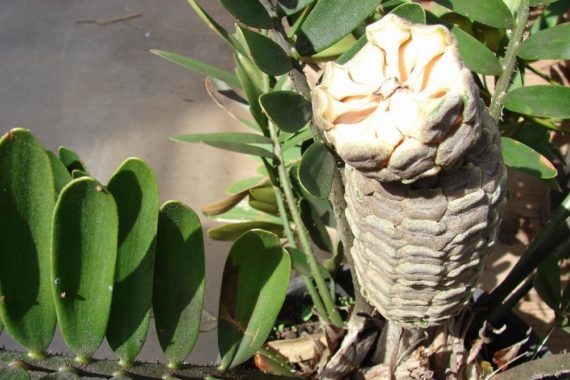

Zamia is able to withstand the direct rays of the sun, but for this it must undergo gradual adaptation, otherwise it will not be possible to avoid the appearance of sunburn. The ideal location is considered to be in the middle of the window sill from the side of the west, south or east window.
As the plant grows, it gradually tilts in the direction from which the light falls on it, so normal maintenance should include periodic rotation of the pot 90 °. This should be done approximately every six months.
Temperature regime
Zamia is an inhabitant of the warm humid tropics, so she needs warmth to feel good. In summer, it does not tolerate excessive heat very well; at room content, the temperature should not exceed 25 ° C, but on the street it is capable of withstanding higher rates.
In the summer months, the plant feels very good in the garden or in the yard, and for better home care, the pot can be taken outside, but in the fall you need to have time to bring it into the house until the average daily temperature drops to 10 ° C. This species is able to endure a short night cold snap to 0 ° C, but if it lasts longer than a couple of hours, the plant may die.
In addition, a sharp change in temperature is also destructive for a flower, therefore, when it is introduced into the house, it is necessary to ensure a constant increase in this parameter.
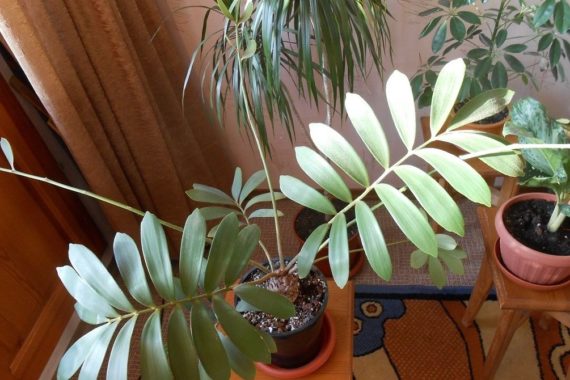

Humidity
Zamia needs to provide sufficient air humidity from 60 to 70%. At home, this is achieved by several methods:
- Daily spraying from a spray bottle of the plant itself and the space nearby. It is best to spray in the morning, when the maximum humidity is observed in the natural environment.To do this, use warm softened water without hardness ions, since hard water can cause white salt spots on the leaf plates, not only spoiling the decorative appearance, but also causing various diseases.
- Application of a humidifier.
- Rub it with a damp sponge once a week.
Placement close to the aquarium is a good choice to ensure optimal humidity in home care. In the immediate vicinity of radiators during the heating season, the plant will suffer and may react to excessive dry air by losing foliage.
Watering
Watering should be moderate, but periodic. Drying the top layer of the earth leads to the rapid shedding of yellowed leaves. Excessive watering in the care leads to damage to root rot, so excess water from the pan is poured out after 20 minutes.
For irrigation, it is best to use rain or melt water, warmed to room temperature or a couple of degrees above it. Applying cold water puts the plant under stress and can kill the flower.
In the summer months, the frequency of humidification is once a week, and in winter it is reduced to once every half a month.


Transfer
Too frequent transplants are unnecessary for good care. The need is judged by the fact that the root system hardly fits in the pot and the roots begin to appear through the drainage holes. After the transplant, the growth of the zamia slows down, since it takes a long time to get away from stress, so you should not disturb the flower once again. During the first 2-4 years, young specimens are transplanted into a container, slightly larger than the previous one, every 1-2 years. Then the frequency of transplants is reduced to once every 3-5 years. The best time for a transplant is April.
It must be remembered that all parts of the zamia are poisonous and secrete toxic sap, therefore, contact care for the flower must be carried out with gloves.
You can purchase a commercially available substrate of the universal type or for decorative leafy, as long as it is permeable and rich in nutrients. Sometimes the soil is prepared independently. This will require the following components:
- sod land;
- high-moor peat;
- rotted three-year-old humus;
- coarse river sand;
- leafy land.
All components are taken in the same proportions. Add charcoal if desired. A prerequisite is an expanded clay drainage layer at the bottom of the pot.
It is best to carry out transshipment at home without disturbing the old earthen coma. After filling all the voids with soil, the soil is watered abundantly. The first month after that fertilization is not applied.
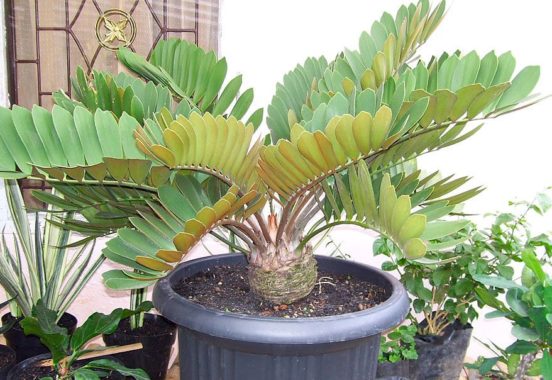

Top dressing
For fertilizing zamia, mineral complexes for decorative deciduous plants are used. Throughout the summer, they are used once every half a month, and with the arrival of the cold season, feeding is completely stopped.
Reproduction of zamiokulkas
Zamioculcas are propagated by dividing an adult bush during transplantation. In addition, zamioculcas can be propagated by leaf-bud cuttings (a whole complex leaf with a bud), as well as by separate leaf plates. When dividing the leaf plate into separate parts, make sure that each division has a growth point. Before rooting, the division of leaves or cuttings of zamiokulkas should be sprinkled with ground activated charcoal or charcoal, slightly dried, and then. root in a mini-greenhouse in a mixture of sand and peat. The desired rooting temperature of cuttings and leaves of zamiokulkas is above + 20 ° C. If you are rooting cuttings in a regular container, then place it in a polyethylene bag or cover it with glass to create high humidity and temperature necessary for the formation of zamioculcas roots. After a while, tiny nodules form at the base of the cuttings or leaves, which means the successful rooting of the zamiokulkas.After that, the rooted cuttings and leaves of zamiokulkas are planted in separate small pots. After about six months, the first shoots will begin to appear.
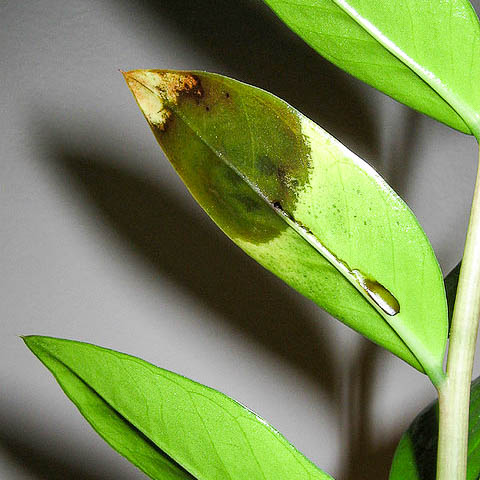

Photo gallery
Zamia is often confused with zamioculcas, but it has pointed leaves, a trunk hidden underground, and belongs to the aroid family.
The plant is poisonous - the toxins contained in its parts cause allergies, manifested by rashes, irritation and itching, and can also cause liver and kidney failure, paralysis and dehydration. Therefore, it is important that children and pets do not have access to it.
Zamia seed growing
To carry out seed reproduction, a florist must take seed and sow it on the surface of a peat-sandy soil mixture, which should be filled in a special container. Sprinkle the seeds on top with a thin layer of soil, water the substrate and cover it with polyethylene or a piece of glass.
After planting, it is necessary to ventilate the seedlings daily and, if necessary, moisten the soil using a spray bottle. After the shoots appear and several leaf plates are formed on them, they can be planted in small pots with soil suitable for zammy, having previously made drainage at the bottom of the planting tank.
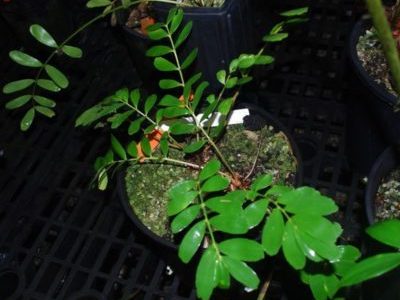

Pests
| Pest | Signs | How to fight |
| Shield | Leaves lose color, weaken and dry, dark spots appear on them | Remove insects from the plant, wipe the leaves with soapy water, treat with Aktellik or Fitoverm |
| Spider mite | A thin web appears on parts of the plant | Treat with insecticides, for example "Agravertin" |
Expert opinion
Mokhov Andrey Petrovich
Graduated from KubSAU specialty: agronomy
Insecticide treatment is carried out in 2 or 3 stages with an interval of 7 days.
Description and habitat
The evergreen flower Zamia belongs to the Zamiaceae family, numbering 26 species. Their habitat is wide enough and stretches from Cuba, Florida to Brazil. Favorite growing places are river banks, hillsides in tropical and subtropical regions of America. The flower got its name because of the type of fruit that looks like damaged pine and spruce cones.
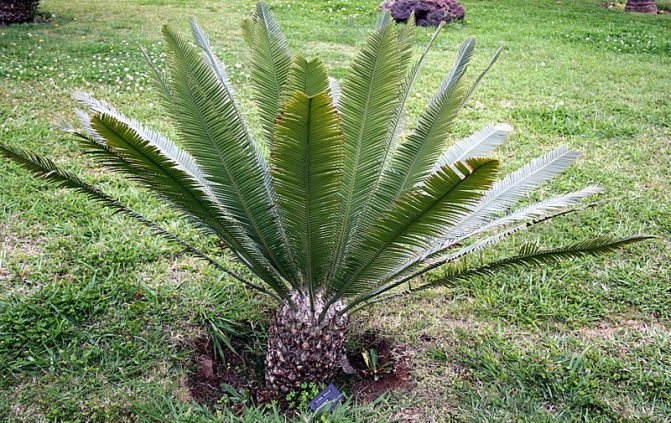

Translation of the name from Latin means damage. This is one of the oldest representatives of flora on earth, its relatives - Cycovniks (plants belonging to the genus gymnosperms) served as food for dinosaurs more than 300 thousand years ago, in the Devonian period. Representatives of this family are stunted, with a short, smooth trunk, which has characteristic scars from fallen leaves, sometimes several thorns. A significant part of the barrel-shaped trunk located underground is in the form of an elongated tuber. Dense green, oval leaves are few in number, have even, less often toothed edges, grow alternately, bifurcate at the base. They are porous to the touch, have pronounced longitudinal veins.
The leaf axis of the Zamiev family is called Rakhis - this is the central vein to which stipules are attached
Outwardly, the flower looks like a small palm tree. Due to its appearance, high decorative qualities and unpretentious care, it is widely used in indoor floriculture. This family belongs to gymnosperms, dioecious plants that have a female and a male. When the reproductive age is reached, megastrobila in the female and microstrobila in the male are formed in the rosette of leaves.
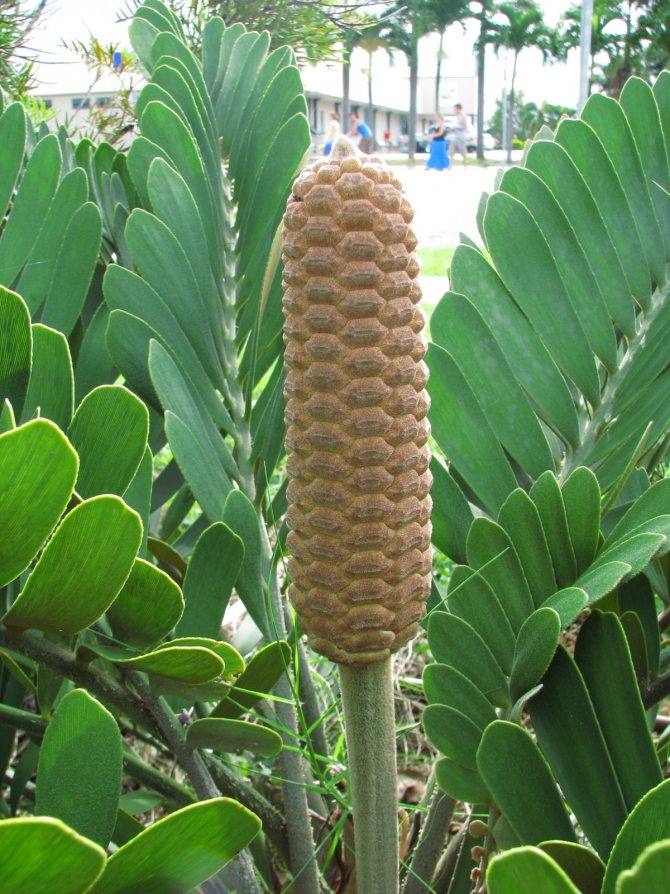

Strobilus (Strobilus), translated from Greek as a lump, are the organs of reproduction. Megastrobilae, similar to large spruce or pine cones, on which spore-bearing modified leaves - sporophiles - are located. Each such sporophilus bears two ovules on the lower surface of its scutellum. Microstrobila or male cone, forms pollen, which, falling on the ovum of a female, participates in the reproduction of the species.Usually megastrobils are much larger than the male bump in weight and size, they are light brown in color.
Growing difficulties
In the process of growing zamia, some difficulties may arise:
- yellowing of leaf plates - occurs when the roots are injured, for example, after transplantation. To restore the root system, it is recommended to add a little "Kornevin" to the soil during watering, which will stimulate the growth of new roots;


- yellowing and falling leaves - the plant was affected by a fungal rot. You can save the zamia by transplanting into new soil, after removing the affected roots. Before planting in a new soil, the roots of the plant are soaked for 20 minutes in Fitosporin;
- discoloration, dark spots, shedding - associated with infection with a scabbard. It is necessary to fight "Aktellik" according to the instructions;
- the appearance of a cobweb on a plant, wilting of leaves - spider mite infestation. The pest can be overcome by treatment with "Agravertin" according to the instructions.
Trimming the back
Pruning of the decorative palm is not carried out due to the uneven growth of the leaf blades. In addition, the leaves grow slowly, which means that pruning will negatively affect the plant.
Unlike other crops, zamia will not become more luxuriant from the removal of branches, but, on the contrary, after the procedure, it will begin to dry out and die. The maximum that a florist can do is remove dead shoots if necessary.
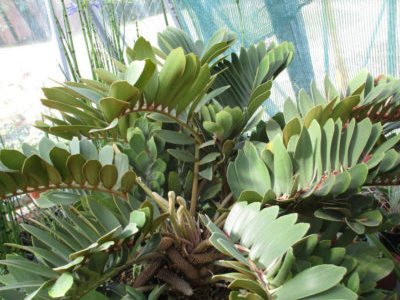

Flowering and fruiting
Zamia is the owner of leathery, glossy, feathery or oval foliage. The leaves, colored first light green and then olive, are arranged on long thin petioles. At the base, they are divided into narrow and wide lobes, have solid or serrated edges, sometimes parallel veins are noticeable on the lower side of the leaf.
It is a gymnosperm dioecious plant. Instances with female flowers show a semblance of flowering, when strobila appear between the sepals at the base of the stem - reproductive organs reaching 5-15 cm and outwardly resembling a cone. On male specimens, microstrobilis are formed, but, due to their small size, they are often invisible.
This happens in the middle of summer and only in the natural environment, since it is impossible to create the necessary microclimate at home.
Zamia in Feng Shui philosophy
Eastern philosophy of Feng Shui says that zamia is able to attract wealth and happiness to the house. To get a positive effect and attract money, you need to hang special Chinese coins on the shoots of the plant and water the zamia with water charged for abundance.
Did you know? In ancient times, zamia was used as a raw material for the manufacture of clothing by the American Indians.
Also, according to the doctrine, the location of the flower in the apartment affects the fate of the owners in different ways. When placed in a living room or kitchen, the plant will bring good luck. If you install a pot in your office, the flower will help you in your career.
Thus, it is not difficult to grow zamia at home, the main thing is to follow the care recommendations in order to ensure the normal growth of the flower to maintain its decorative appearance.
Reproduction
Usually, zamia is propagated in two ways: cuttings and seeds. Let us consider in more detail the whole process of reproduction of each method separately.
Cuttings
For cuttings on a plant, a young shoot is selected and carefully separated with a sharp knife from the mother part. The stalk must be placed in water and wait for the roots to appear. After the roots appear, the cuttings are planted in soil based on peat and sand (1 to 1) so that the zamia builds up a strong root system.


The planting pot is chosen 6 cm in diameter, medium height. A year later, the plant can be transplanted into the soil with the addition of leafy, sod land and humus (all in equal parts), a layer of expanded clay is poured onto the bottom of the pot.
Growing from seeds
To grow zamia from seeds, you need to purchase seed material in a specialized store. Seeds must be sown in a peat-sand mixture (1 to 1) in wide long containers or separate plastic cups.
Sowing scheme:
- 1 cm deep, 4–5 cm between each seed, 5 cm between rows.
- After the seeds are buried in the soil, the soil is sprayed on top from a spray bottle and covered with a transparent plastic wrap to create a greenhouse effect.
- Every day, the seedlings are aired by removing the film for 1 hour.
- After emergence, the film is removed and the plants continue to grow up to 5 cm in height.
After the zamia gets stronger, it can be transplanted into permanent pots, the soil is used the same as in the case of propagation by cuttings.
Important! In order for the seeds to germinate, the air temperature in the room is kept at +25 degrees, the containers are placed on a well-lit windowsill.
General information
Zamia naturally grows in the tropics and subtropical parts of North and South America. Most plant varieties have a smooth, pear-shaped stem that is buried deep in the ground.
The leaf plates are located on the branches, framing them from both sides to the very top. They have an elliptical shape and are on a long petiole. Young leaves resemble a fern, dividing in two at the base.
In nature, the culture blooms in the middle of summer, and after flowering, zamia forms fruits similar to hollow cones. However, the cultivated plant does not bloom or does it very rarely.
In care, the culture is not whimsical, but at the same time it has a very effective decorative appearance. Therefore, if a florist wants to replenish his flower collection with a mini-palm tree, zamia will be an ideal option for him.
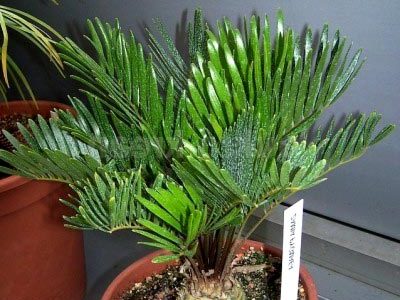

Which pot to choose?
The pot is needed not too deep, with a diameter slightly larger than the root system of the plant. The most suitable material is unglazed clay, such a pot is quite durable and breathable.
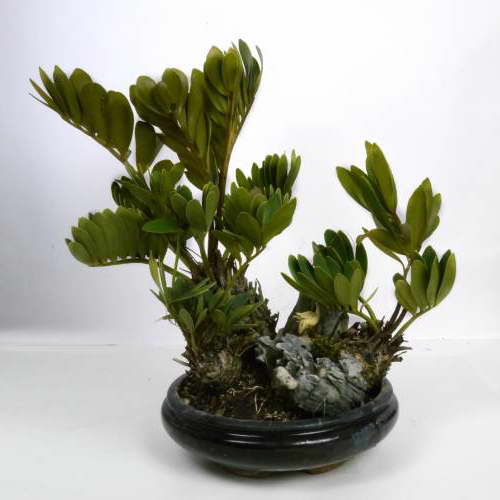

A prerequisite is the presence of drainage holes. Expanded clay, clay shards, brick chips can be used as drainage.
Classification and appearance of zamiokulkas
Zamioculcas - another representative of the Aroids (Araceae), loved by room designers and came into fashion in the early 2000s. Before him, monstera, scindapsus, anthurium and others were confidently "registered" in indoor floriculture. The genus Zamioculcas consists of a single species. Zamioculcas Zamielistny outwardly is very similar to zamia - a plant from another, American, continent. This similarity first misled botanists, and then was reflected in the specific name of the plant.
You can distinguish zamia from zamiokulkas by leaf blades - in the first they are in the form of a rounded spatula, and in the second they are pointed. Zamia stores water in a thick trunk, the trunk of a dollar palm tree is not visible as such - a bunch of feathery leaves grows from the ground. Both plants are toxic, but zamia has surpassed its "namesake" - it is much more poisonous and is not bred in domestic culture.
Zamioculcas was first discovered in 1828. Madagascar at that time enjoyed increased attention among collectors of exotic plants, one of them was Konrad Loddjes. He became the discoverer of the Emerald Palm - such a poetic name was awarded to Zamiokulkas. Some old works contain the first name of the zamiokulkas - Caladium, i.e. related to calla lilies.


The modern name was given in 1908 by the German botanist Adolf Engler. Several closely related subspecies, growing both in Madagascar and in East Africa, were combined into one species. Zanzibar, Tanzania, Kenya and Mozambique are the natural habitat of Zamiokulkas - territories with an extremely hot climate. This super-resistant plant inhabits both hot gravelly slopes and the deep shadow of gorges, dry sands and humid mountain forests.Zamioculcas is not afraid of wildfires in the savannah - the deeply hidden root gives fresh leaves instead of burnt ones. If the animals trample the bush, then a new "palm" grows from each leaf. So he lives in nature - persistent, like a true African.
The appearance of zamiokulkas, bred at home, is no different from the natural form. It is a large plant with glossy odd-pinnate leaves. The leaf can reach one and a half meters in length, has a thickened petiole - rachis. It grows slowly - it gives a maximum of 4-5 leaves per year, as it grows up - one or two leaves, no more. In the event of a lack of water, the plant discards most of the leaf blade, leaving the rachis as a reservoir of moisture.
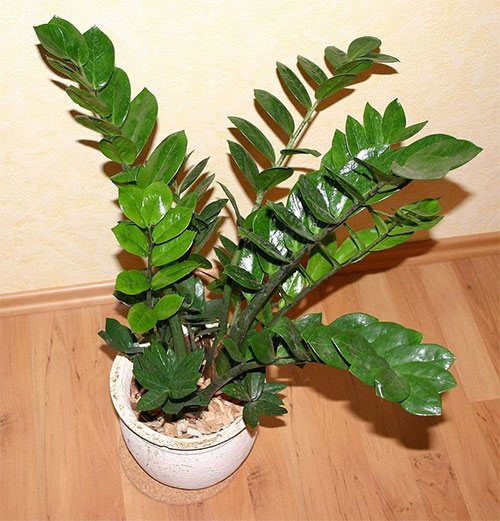

But the main "strategic reserve" in case of drought, zamioculcas stores underground - its barrel-shaped rhizome, in nature, can reach half a meter in diameter. A home flower grows a rhizome as much as the volume of the pot allows. It happens that a plastic vessel does not withstand the pressure from an overgrown root and deforms, or even cracks. Nourishing roots extend from the main rhizome from above. In addition to nutrition, they can perform the function of respiration and even partially photosynthesis - in case the plant has to shed the leaves.
The dollar palm tree blooms unexpectedly modestly - an ear is formed at the very ground, wrapped in a faded green blanket. However, the flower has its admirers - termites, therefore in America the inflorescence of zamiokulkas is called ant corn. Russian insects did not appreciate the "dollar" nectar (maybe it is for the better ...). The opinion that a flower dies after a single flowering is incorrect - zamiokulkas lives up to 10 years at least, and in its homeland it is considered an immortal tree at all.


The selection of zamiokulkas is at the very beginning of the path - at the moment, only one resistant variety has been bred, having a 60-centimeter compact bush.
Beware, the flower is poisonous!
The plant that we will now learn to transplant belongs to the aroid family, and its juice contains poison. Of course, it is impossible to get a fatal burn from a flower, but in places of contact with a bare incision on the sheet, the skin will be damaged.
Redness, itching, and feeling unwell are possible. But the biggest harm that a plant can bring is allergies and even anaphylactic shock.
This is an exotic plant that cannot be found with fire in the natural conditions of our country during the day, so be careful. If you buy a small sprout of zamiokulkas home, choose a safe place to place it, and carry out all work with gloves.
Dividing the bush
Dividing a bush is the easiest way. In this case, an adult bush is simply removed from the pot and divided into equal parts so that each new bush gets a decent part of the root system with tubers. Very often, the plant, after leaving the pot, simply disintegrates into the parts necessary for transplanting.
After separation, the rhizome is dried, pots with fresh substrate are prepared, each part is planted in a separate container. Observe the plant after transplanting. Note that 90% of the separated bushes tolerate this procedure perfectly.
How to grow zamioculcas from a leaf: the second way of reproduction of exotic
For growing from a leaf, you need to cut off several leaves obliquely, and sprinkle the cut points with charcoal. If there is no wood, then we recommend crushing 2-3 tablets of activated pharmacy.
The leaf dries up, and you prepare the soil and pot for rooting.
- Which pot to choose is up to you. For small sheets of zamiokulkas, plastic cups, shallow plastic pots, mini planters are suitable. Do not choose a beautiful flowerpot for the initial planting - the plant grows quickly, and soon it will have to dive into another container.
- At the bottom of the selected container, lay out a layer of polystyrene, expanded clay or crushed brick - this is our drainage.
- Now we are preparing and filling the soil. The ideal combination of soil for zamiokulkas is peat and overfilled in a ratio of 2: 1, respectively.
- Now moisten the soil, take the cut leaf and submerge it in the substrate. Planting to a depth of 1–2 cm. Then water and place in a warm place under diffused light. It is recommended to cover it with a jar so that the leaf does not dry out and is in a kind of greenhouse.
The leaves take root immediately after pruning, they are not immersed in water to germinate the roots. A small leaf of zamiokulkas hardens in the soil for 30–45 days, it needs moderate watering. After rooting, the sprout grows rather quickly, and after a few years it can become a donor for new bushes.
Signs and superstitions: the flower of celibacy or female happiness?
Zamioculcas is simply surrounded by various myths and superstitions. Maybe the reason for this is a strange bloom? For example, he was named the flower of celibacy, but this does not mean at all that a woman who breeds zamiokulkas will never marry.
If a woman bought it herself, then her personal life will not stick. And if she was presented with a small sprout of zamiokulkas, luck in love is guaranteed. Do you already have a flowering plant? You can start sewing your wedding dress. Zamioculcas helps to get married, and ficus helps to conceive a baby.
The value of plant maintenance for women and men
The magical properties of a Feng Shui flower increase a hundred times if it was presented on a special day: birthday, New Year, Christmas. It is also useful for career growth, material wealth and health, being in the house - for money and well-being.
There is a belief that a flower feels an attitude towards itself and thanks its mistress or owner with positive energy of good luck.
The plant that was presented to you must be transplanted immediately, this will have a positive effect on attracting money. Drainage needs to be done at the bottom of the pot, and some gardeners use coins instead of expanded clay. It is said that in this way the plant is tuned in to make a profit.
Of course, one cannot say that this is correct or beneficial for a flower, because coins can react with water, fertilizer.

